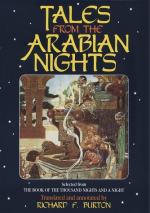Another Arabian version is found—as Sir Richard Burton points out, note 1, p. 119—in “The Fisherman’s Son,” one of the tales translated by Jonathan Scott from the Wortley Montague Ms. text of The Nights, where the hero finds a magic ring inside a cock: like Aladdin, he marries the King’s daughter and has a grand palace built for him by the genii. The ring is afterwards disposed of to a Jew, in the same manner as was the Lamp to the Magician, and the palace with the princess is conveyed to a distant desert island. The fisherman’s son takes to flight. He purchases of a man who offered them for sale a dog, a cat, and a rat, which turn out to be well-disposed magicians, and they recover the ring from the Jew’s mouth while he is asleep. The ring is dropped into the sea accidentally while the animals are crossing it to rejoin their master, but is brought to the hero by a fish which he had returned to the sea out of pity in his fisherman days. The genie conveys the palace back again, and so on.—In a Mongolian version ("Siddhi Kur”) a young merchant parts with all his wares to save a mouse, an ape, and a bear from being tortured to death by boys. One of those creatures procures for him a wishing-stone, by means of which he has a grand palace built and obtains much treasure. He foolishly exchanges his talisman with the chief of a caravan for all their gold and merchandise, and it is afterwards restored to him by the grateful and ingenious animals.—In a Tamil version—referred to by Sir Richard, p. 30, note 2—which occurs in the “Madanakamarajankadai,” a poor wandering young prince buys a cat and a serpent; at his mother’s suggestion, he sets the serpent at liberty and receives from his father a wishing ring. He gets a city built in the jungle— or rather where the jungle was—and marries a beautiful princess. An old hag is employed by another king to procure him the princess for his wife. She wheedles herself into the confidence of the unsuspecting young lady, and learning from her the properties of the ring, induces her to borrow it of her husband for a few minutes, in order that she (the old trot) might apply it to her head to cure a severe headache. No sooner has she got possession of the ring than she disappears, and having delivered it to the other King, he “thought” of the princess, and in the twinkling of an eye she is carried through the air and set down before him. The ring is recovered by means of the cat which the hero had fostered, and so on.
Sir Richard has referred to a number of Italian versions (p. 30, note 2), which will be found epitomised in a most valuable and interesting paper, by my late friend Mr. H. C. Coote, on the sources of some of M. Galland’s Tales, in the First Part of the Folk-Lore Record for 1880, and, in conclusion, I may briefly glance at a few other European variants. Among those which not only bear a close analogy one to another but also to the Asiatic versions cited above are the




